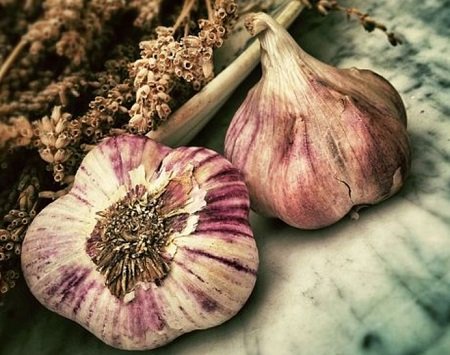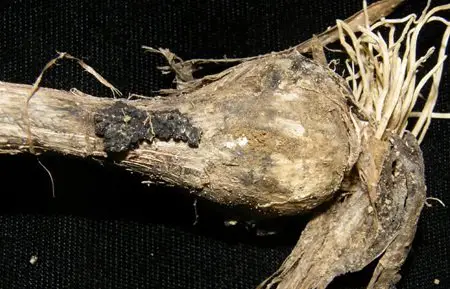A large amount of garlic is lost during growth and after harvesting due to diseases.
Garlic crop diseases are predominantly initiated by a variety of fungi. Mostly, these fungi are naturally present in the soil or in decaying plant matter in the form of inactive spores.
Although these spores are situated in the soil and are inactive, they only lead to infection in garlic when conditions are right. Favorable conditions include a windy/rainy climate.
It is important to identify and manage garlic crop diseases for the devastating impact to crop yield.
Here are some important garlic crop diseases that can affect your garlic harvest output and you can manage them.
Botrytis Neck and Bulb Rot (caused by Botrytis porri)
Botrytis Neck and Bulb Rot affect members of the Allium species, which includes garlic, onion, shallots, and leeks. This disease adversely impacts the garlic stems and makes garlic bulbs useless when infected.
This fungus enters the garlic plant either through the stems, tissues, or wound openings on leaves and bulbs. This dark gray to black fungus show as spores when looked at up close.
It produces tiny black spots which are called sclerotia. These are structures that allow the fungus to survive long periods in the soil.
Botrytis Rot tends to affect garlic during the end period of maturation or when garlic is being stored. This disease accounts for extensive loss of garlic as it can stay dormant in the soil for longer periods of time in sclerotia form.
Tips to manage Bulb Rot
- Immediately remove any infected plants
- Practice crop rotation (do not consecutively plant members of Allium family)
- Use resistant/treated garlic cloves for planting
- Garlic harvesting must be done only when bulbs are mature
- Avoid creating favorable conditions for Botrytis porri (excessive fertilizer and excessive moisture)
- Cure garlic bulbs properly in low humidity under cold temperatures
- Only remove stems after curing is complete
Soil Requirements of Garlic – Which soil is best for Garlic Growing?
Rust (caused by Puccinia allii)
Rust is a common plant pathogen that originates from a single rust fungi spore. This garlic disease infects leaves which directly affects the size and quality of garlic bulbs. Rust-infected garlic plants can display stunted growth, yellowing of leaves, and fungi fruiting bodies.
Infection begins when spores land on plant leaves, germinate and multiply in the host plant. Rust fungi usually affect one particular part (leaves or bulbs). The infection begins with small white marks which eventually develop into orange elliptical lesions on leaves.
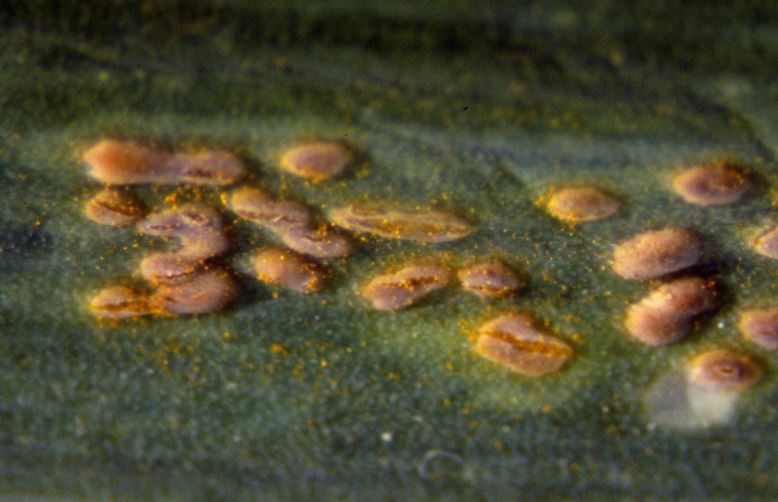
Spores are airborne (passed through the air) and are transmitted from infected plant debris remaining in the field. This makes rust highly infectious, especially when garlic plants lack adequate spacing between plants and rows.
Tips to manage Rust
- Dispose of all remaining plant debris after harvesting crops
- Efficient crop rotation between host and non-host plants
- Control of weeds can help protect against rust infections
- Avoid over-application of Nitrogen (it makes leaves more vulnerable to rust bacteria)
- Increase plant spacing in wet and warm climate regions to allow garlic plants more breathing space
- Applications of Neem Oil can help to protect garlic against rust bacteria
White Rot (caused by Sclerotium cepivorum)
Perhaps the most dangerous agricultural disease of garlic, White Rot can destroy an entire garlic crop. What makes this disease even more fearsome is the fact that it can remain viable in soil for decades!
White rot initially presents itself as dwarfed garlic plants and later progresses to yellowing and death of outer leaves and stems. The most prominent effect is rotting stems above bulbs and the growth of fluffy white mycelia on garlic bulbs.

Rather than affecting individual garlic plants, White Rot will affect a group or cluster of garlic plants.
White rot forms sclerotia which appear as small black spots present on the decaying garlic tissue. Cool and moist conditions attract White Rot fungi. Temperatures of 50℉ to 75℉ are favorable for the disease to thrive.
Tips to manage White Rot
Management of White Rot is difficult since it can live in soil for over 20 years. Most farmers prefer to leave this unusable land and start afresh at a new location.
- Crop rotation and leaving large time gaps between Allium species (onion and garlic)
- Do not transport garlic plant matter from an infected site to an uninfected site
- Clean all tools (farming and harvesting equipment) properly before reuse
- Discard infected plant material
- Use fungicides to manage White Rot populations
- Disinfect garlic cloves with water at 115℉ to prevent infection
When Garlic Is Ready To Harvest? Tips for Beginners
Downy Mildew (caused by Peronospora destructor)
Downy Mildew is a fungal infection that affects garlic among other suitable plant hosts.
Garlic bulbs are left useless and rotten after this infection runs its course. Downy Mildew is known to cause a light violet to purple color fungal growth on the undersides of leaves. This disease usually occurs in wet and humid weather conditions.
Visual symptoms include fading leaf color from pale green to brown and lastly yellow. Eventually, leaves lose their composure and fall off. Bulbs become wet and as a result, they rot rapidly! Any young growth results in twisting and deformed leaves.
The presence of Downy Mildew is sporadic since it can remain viable in the soil for repeating years or re-emerge after a 1-year absence.
Tips to manage Downy Mildew
- Avoid creating favorable conditions for Peronospora destructor (wet, moist, and humid)
- Use drip irrigation (other irrigation methods may facilitate the spread of Downy Mildew)
- Remove all plant debris after complete harvest of a crop
- Refrain from planting susceptible crops (garlic) in infected fields
- Apply fungicides to reduce the population of this fungus
- Practice crop rotation with eligible crops (crops that do not attract Downy Mildew)
- Use garlic bulbs that are modified and resistant to fungal diseases
Purple Blotch (caused by Alternaria porri)
This infection manifests in older leaves in the form of lesions and depressed watery wounds. As time passes, these lesions change in color to purple, brown, and yellow. Finally, it results in wilting and the death of leaves.
The bulbs usually become infected through lesions at the stems and neck of the garlic bulbs. The infection diminishes the size of the garlic bulb, garlic bulbs infected with Purple Botch will rot during storage.
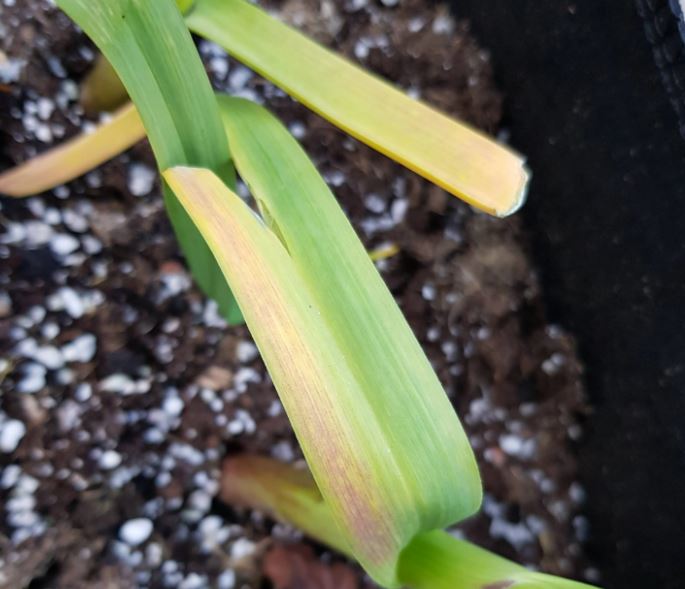
Certain areas of the bulb become soaked and begin to rot, during this time the bulbs change from a red-purple shade to a brown and black rotten color.
Purple Blotch infection is more prominent in warm and humid regions.
Tips to manage Purple Blotch
- Use resistant or high tolerance garlic clove variants
- Increase plant spacing to improve air circulation between plants
- Control weeds (weeds retain moisture in the soil and stimulate Purple Blotch fungi)
- Rotate Allium crops after 3 years
- Dispose of plant remains properly to avoid infecting current crops
- Harvest during the dry season
- Harvest bulbs delicately
- Follow-through with proper curing procedures, remove leaves after the curing process is complete
How to Grow Garlic Indoors? Growing Garlic Bulbs and Scapes in Pots
“Blue Mold”-Penicillium hirsutum (Decay of garlic)
The fungi Penicillium hirsutum is known to affect garlic bulbs directly.
The fungal growth on rotting garlic bulbs has a distinct blue-green color, making it easy to check. Of course, there are certain conditions that must be met in order for these fungi to damage garlic bulbs.
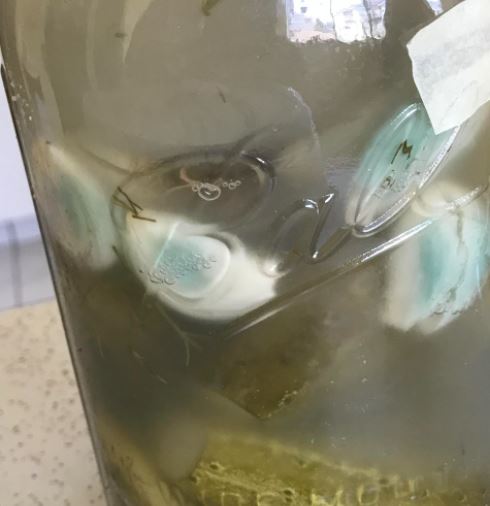
Penicillium only affects those bulbs that have been damaged during their harvesting or storage period. It also only affects bulbs that at compromised after being under attack by another disease (Blue Mold commonly occurs on bulbs with Fusarium infection wounds.)
Garlic bulbs can be damaged by harvest machinery, penetrating wounds from other plants, rough handling (dropping and throwing) resulting in bruises on the bulbs, etc.
Tips to manage Blue Mold”-Penicillium hirsutum
- Delicate handling can eliminate any chance of post-harvest damage.
- Do not delay curing garlic after harvesting
- Split open garlic heads only when planting and not too far in advance
- Keep damaged bulbs separate
- Store garlic in low humidity areas at a temperature below 39℉
- Identify and destroy infected bulbs and cloves prior to planting
Fusarium spp. Bulb Rot
All Fusarium fungi cause damage to garlic and Allium members.
This soil-borne pathogen first appears as discolored leaves, dead leaves, and plant wilting. It then progresses to stems and bulbs adopting a red to brown or purple color.
The infection reaches the basal plate and enters the garlic bulbs. At this point, the bulbs will appear brown. They can appear watery when cut open.
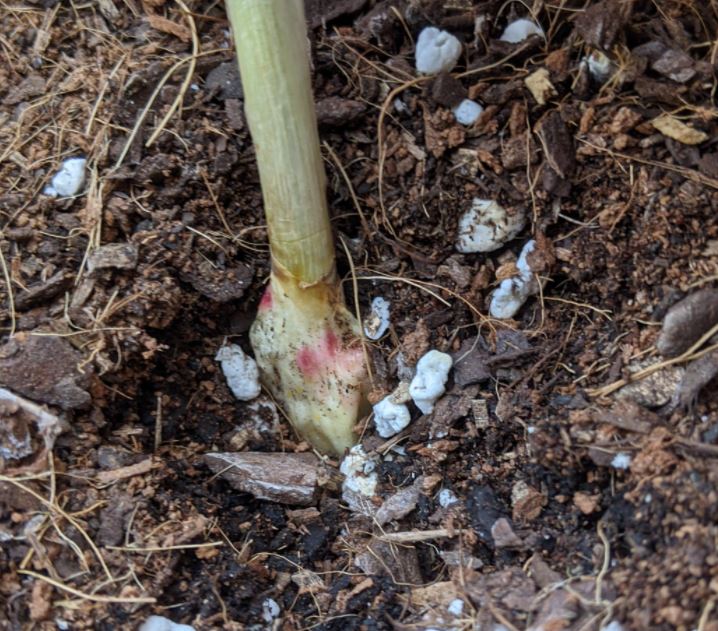
The fungal growth even penetrates the wrapping and affects cloves by creating cracks. Here it eats away the tissue leading to a great decrease in clove size.
Both losses of color and texture are undesirable and an evident product of disease.
Fusarium bulb rot can occur at any time during garlic bulb maturation. This applies to garlic in the field or garlic stored. Fortunately, this disease rarely passes from one garlic bulb to another during the storage phase, giving some peace of mind!
Tips to manage Fusarium spp. Bulb Rot
- Whenever possible, use garlic varieties resistant to Fusarium fungi
- Practice crop rotation (plant Allium species after 3 to 4 years)
- Avoid damaging bulbs since this is how this soil-borne disease enters plants
- Store and cure bulbs at 39℉ to avoid infection after harvest
- Conduct proper sanitation on fields -plant materials post-harvest
Black Mold (Caused by Aspergillus niger)
Notice any black or gray areas when cutting into garlic? This could be due to Aspergillus niger, the causative pathogen of Black Mold, a mold that is more common in onions.
This fungus normally affects damaged garlic bulbs and enters the plant through an injury in contact with the soil.
It is important to note this disease seldom affects healthy bulbs with no injuries. Also, it is more prominent during warm growing temperatures and when stored in temperatures above the regular standard.
Entry of spores can occur through openings in the bulb neck, outer wrapping, basal, plate, or even roots. This disease happens post-harvest and it survives only on decaying matter in the soil, its primary host is onions but it can affect garlic in favorable climates and conditions.
Tips to manage Black Mold
- Carefully harvest, handle, and transport garlic bulbs to reduce instances of injury through which the fungus can enter bulbs
- Do not delay harvesting as bulbs may become susceptible to Black Mold spores
- Cure garlic bulbs naturally without using artificially heated air
- Store and transport garlic bulbs at a temperature of 40℉ to slow down or inhibit the growth of Aspergillus niger fungus
End Note
Preventing major garlic losses will depend on how well you clear your field or growing area after harvest. Follow the above guidelines to make every harvest sustainable.

